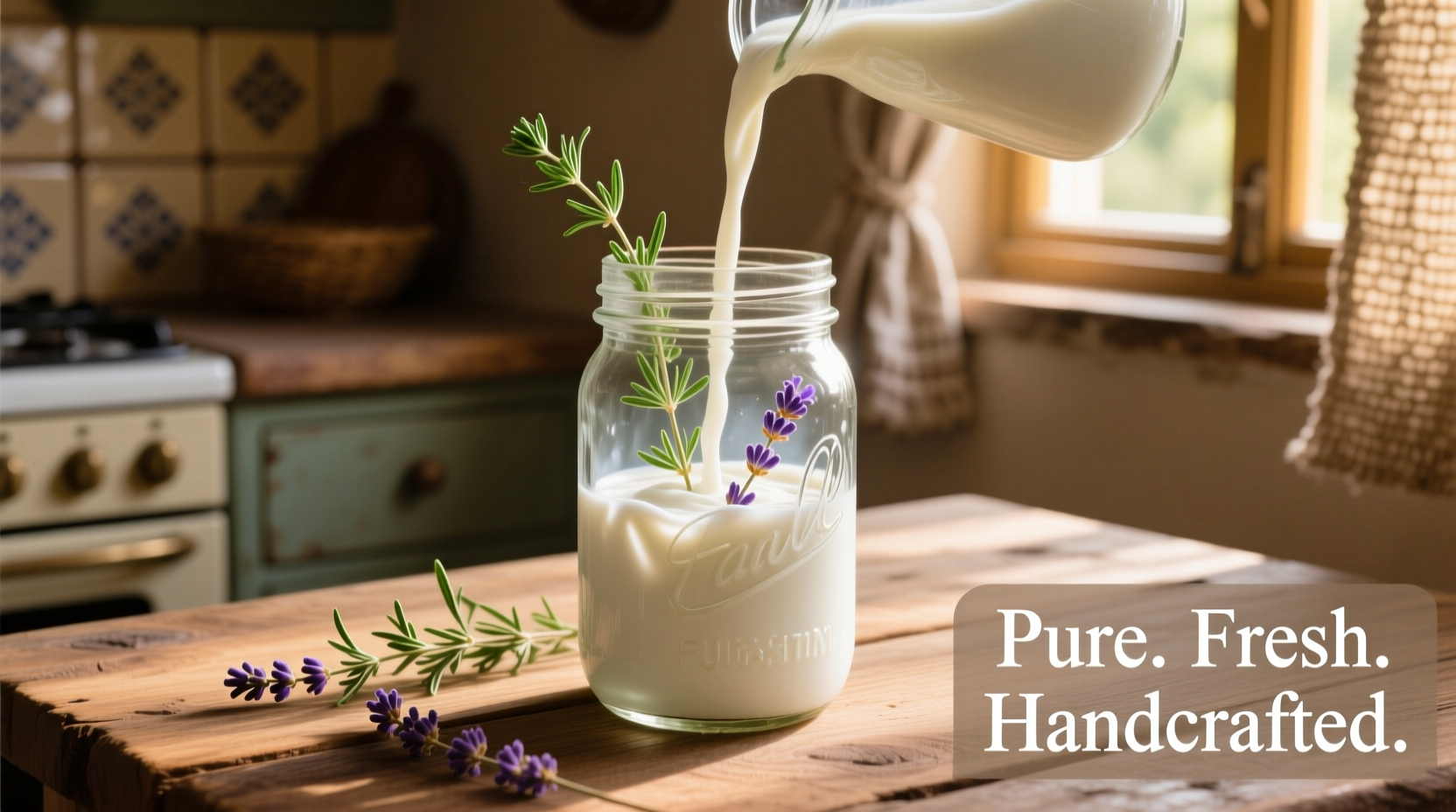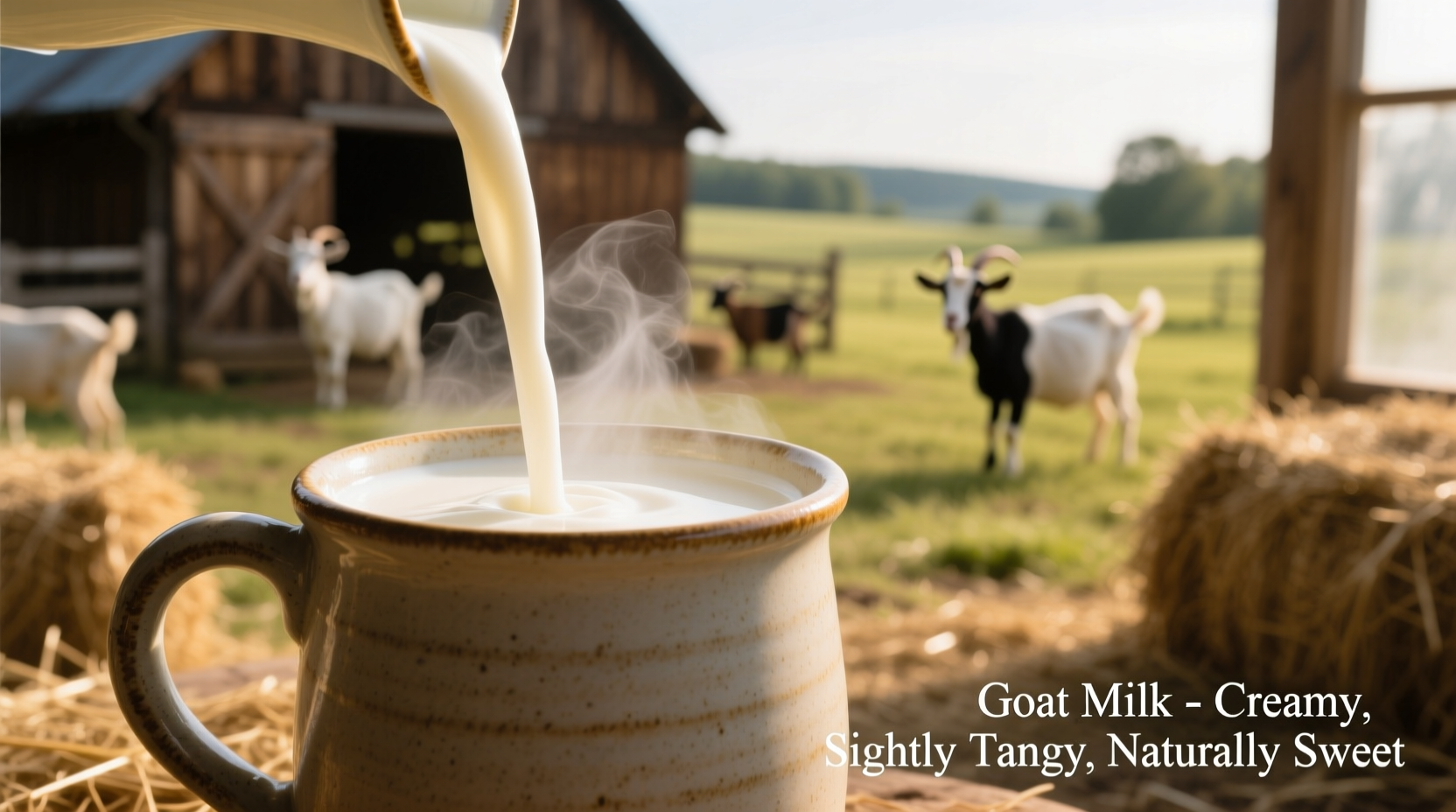Understanding Goat Milk's Unique Flavor Profile
When you first taste quality goat milk, you'll notice its clean, mildly sweet flavor with a subtle tang—somewhere between cow milk and buttermilk. The distinctive characteristic many describe as “goaty” actually comes from volatile fatty acids (caproic, caprylic, and capric acids) naturally present in goat milk. However, this flavor note isn't always strong; properly handled fresh goat milk from well-cared-for animals has only a delicate earthy undertone.
Texture plays a significant role in the overall experience. Goat milk's smaller fat globules create a naturally homogenized, creamier mouthfeel without the need for processing. This gives it a smoother consistency that many find more pleasant than conventional cow milk, especially when consumed cold.
| Characteristic | Goat Milk | Cow Milk |
|---|---|---|
| Primary Flavor Notes | Sweet, earthy, subtle tang | Creamy, grassy, neutral |
| Mouthfeel | Smooth, naturally homogenized | Can separate, often processed |
| Fat Globule Size | 2 microns (smaller) | 3-4 microns (larger) |
| pH Level | 6.4-6.7 (slightly higher) | 6.5-6.7 |
| Common Misconceptions | “Always tastes strong” | “More natural flavor” |
Why Goat Milk Tastes Different: The Science Behind the Flavor
The unique taste of goat milk stems from its chemical composition. According to research published in the Journal of Dairy Science, goat milk contains higher levels of short- and medium-chain fatty acids, particularly caproic, caprylic, and capric acids, which contribute to its characteristic flavor profile. These compounds are more volatile and noticeable to our taste receptors than the longer-chain fatty acids predominant in cow milk.
Interestingly, the perception of “goaty” flavor often relates to handling practices rather than the milk itself. The University of California’s Dairy Research Program notes that when goats are properly managed—kept clean, milked hygienically, and cooled immediately—the resulting milk has only a mild, pleasant flavor. Stronger flavors typically develop when milk sits at room temperature too long or when bucks (male goats) are kept near does (females) during milking.

Factors That Influence Goat Milk Taste
Your experience with goat milk depends on several key variables that affect its final flavor:
Breed Differences
Not all goat milk tastes the same. Different breeds produce milk with distinct flavor profiles:
- Nubian goats: Produce milk with higher butterfat content (3.5-4.5%), resulting in a richer, sweeter flavor
- Saanen goats: Yield more milk with a milder, cleaner taste profile (3.0-3.5% butterfat)
- Alpine goats: Create milk with balanced flavor and moderate butterfat (3.0-3.8%)
Diet Impact
Goats are browsers, not grazers like cows, which significantly affects milk flavor. When goats consume diverse plants including leaves, shrubs, and weeds, their milk develops more complex flavor notes. The USDA Agricultural Research Service confirms that goats fed primarily on browse (woody plants) produce milk with different volatile compounds than those fed grass or grain, creating subtle flavor variations that reflect their terroir.
Processing Methods
Pasteurization temperature dramatically affects flavor. High-temperature pasteurization can create a “cooked” flavor in both goat and cow milk, while flash pasteurization preserves more of the fresh taste. Raw, properly handled goat milk offers the purest expression of its natural flavor profile, with many tasters noting floral or herbal notes depending on the goats' diet.
How First-Time Drinkers Typically Experience Goat Milk
If you're new to goat milk, your first sip might surprise you. Consumer taste tests conducted by the American Dairy Science Association reveal that approximately 65% of first-time tasters describe the initial flavor as “fresher” and “cleaner” than expected, with only about 20% detecting any noticeable “goaty” flavor in properly handled milk.
Many people find they prefer goat milk in certain applications:
- Coffee and tea: The subtle tang complements dark beverages better than cow milk
- Cereal: The natural sweetness enhances grain flavors
- Cooking: When heated, the flavor differences become less pronounced
For those transitioning from cow milk, starting with processed goat milk products like yogurt or cheese can provide a gentler introduction to the flavor profile before trying the fresh milk.
Who Might Prefer Goat Milk's Flavor Profile
Certain groups often find goat milk's distinctive taste appealing for specific reasons:
- People with mild dairy sensitivities: While not lactose-free, goat milk's different protein structure and smaller fat globules make it more digestible for some, allowing them to enjoy dairy flavors they previously couldn't
- Culinary enthusiasts: Chefs appreciate goat milk's clean flavor that doesn't overpower delicate dishes
- Parents: Many find children accept the slightly sweet flavor of goat milk more readily than cow milk
- Health-conscious consumers: Those seeking alternative nutrition profiles often adapt to and appreciate the distinctive taste
Interestingly, cultural background affects taste perception. In Mediterranean and Middle Eastern countries where goat dairy has been consumed for centuries, people typically describe the flavor as “natural” and “pleasant,” while those from regions where cow milk dominates may initially find it “different” or “unfamiliar.” With repeated exposure, most develop an appreciation for its unique characteristics.
Practical Tips for Enjoying Goat Milk
Whether you're new to goat milk or looking to enhance your experience, these practical suggestions can help:
- Start with freshness: Purchase the freshest milk possible—ideally within 3-5 days of milking
- Chill thoroughly: Cold temperatures suppress stronger flavor notes, making the milk taste milder
- Try it in recipes: Use in smoothies, mashed potatoes, or baked goods where the flavor integrates well
- Give it time: Many people report the flavor becomes more appealing after 2-3 weeks of regular consumption
- Compare brands: Different producers yield noticeably different flavor profiles
For parents introducing goat milk to children, mixing it gradually with cow milk (starting with 25% goat milk) can help with the transition. The natural sweetness of goat milk often makes this adjustment easier than expected.
Does Goat Milk Taste Better When Cooked?
When heated, goat milk's flavor profile changes noticeably. The volatile compounds responsible for the characteristic “goaty” notes become less pronounced during cooking, making it an excellent substitute in most dairy applications. Professional chefs often prefer goat milk in:
- Custards and puddings: Creates exceptionally smooth texture
- White sauces: Blends seamlessly without overpowering other flavors
- Ice cream: Produces a cleaner-tasting frozen dessert
- Cheese making: Develops complex flavors as it ages
The smaller fat globules in goat milk create more stable emulsions in cooked dishes, resulting in creamier sauces and smoother textures without additional thickeners.
Frequently Asked Questions
Why does some goat milk taste strong while other tastes mild?
The strength of goat milk's flavor depends on breed, diet, and handling. Properly managed goats produce milk with only a mild flavor, while stress, improper milking hygiene, or keeping bucks near does can create stronger flavors. Freshness also matters—older milk develops more pronounced flavors.
Does goat milk taste sour like goat cheese?
No, fresh goat milk doesn't taste sour like aged goat cheese. The tanginess in cheese comes from the culturing and aging process. Properly handled fresh goat milk has a mildly sweet, clean flavor with only subtle tanginess—much milder than buttermilk or cultured yogurt.
How does goat milk taste compared to almond or soy milk?
Goat milk tastes significantly different from plant-based alternatives. It has a natural sweetness and creaminess that plant milks lack, with subtle tanginess rather than the nutty or beany flavors of almond or soy milk. Unlike plant alternatives, goat milk provides complete dairy flavor with protein and fat structure similar to cow milk.
Does pasteurization change goat milk's taste significantly?
Yes, pasteurization method affects flavor. Flash pasteurization (high temperature for short time) preserves more of the fresh flavor, while vat pasteurization (lower temperature for longer) can create a slightly cooked flavor. Raw, properly handled goat milk offers the purest expression of its natural flavor profile with the most subtle taste.
Why do some people say goat milk tastes like “barnyard”?
This misconception often comes from improperly handled milk. When milk sits too long before cooling or when bucks are kept near milking does, stronger flavors develop. Well-managed dairy goats produce milk with only a mild, pleasant flavor. Modern commercial producers follow strict protocols to ensure clean-tasting milk without barnyard notes.











 浙公网安备
33010002000092号
浙公网安备
33010002000092号 浙B2-20120091-4
浙B2-20120091-4